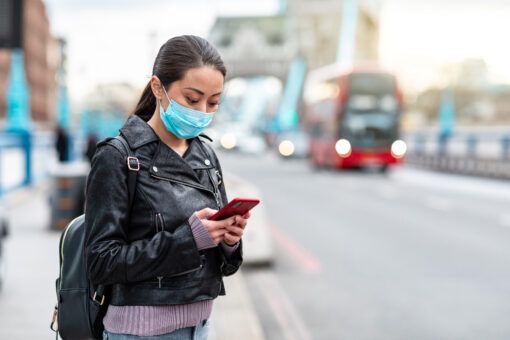
The UK ranks 101 out of 131 countries in terms of poor air quality (ranked from worst to best) according to the latest World Air Quality report.1 Only three European countries – Finland, Estonia, and Iceland have met the WHO-recommended targets of 5 μg/m³. The average PM2.5 in the UK was 8.9 μg/m³. Among capital cities, London is ranked 89 with an average PM2.5 of 9.6 μg/m³. In the UK, 13 cities achieved PM2.5 levels lower than 5 μg/m³. The city with the cleanest air in the UK in 2022 was Midlothian in Scotland, while the most polluted air was reported to be in Faversham, England.
Both London and the UK are categorised under the colour code, green, i.e – it exceeds the WHO PM2.5 targets by 1-2 times.* The implementation of the Ultra Low Emission Zones (ULEZ) has helped improve air quality by a significant 21% in inner London.2 Reports suggest that ULEZ has helped reduce road transport-related nitrogen oxide emissions by 35% and carbon dioxide emissions by 6%, in central London within just 10 months of implementation. 2 The UK Health Alliance on Climate Change is one of a number of health organisations to have expressed support for the expansion of ULEZ to cover all of Greater London in August 2023 to improve air quality and health. Additionally, expansion and bettering of the public transport networks across the UK along with a built environment that promotes active travel would further improve air pollution levels and health. From a health perspective, GP appointments for respiratory symptoms proportionally rise as air pollution levels increase.3 In 2020, exposure to outdoor air pollution contributed to 27,000 deaths in the UK.3 Vulnerable populations, particularly those living in areas of deprivation have significantly higher exposure to both indoor and outdoor air pollution. This increases the risk of asthma, cardiovascular diseases, dementia, cancer and hospital admissions.
The recent cuts announced by the Transport Secretary to the investments in active travel infrastructure from £308 million to only £100 million for the next two years is disappointing.4 The UK Health Alliance on Climate Change joined with a number of organisations condemning this decision saying it represents a backward step for the promotion of health, environment, climate change and economy. Instead, we need ambitious laws such as the Clean Air Bill – Ella’s law – that will help ensure the right to breathe clean air as a basic human right.3
*Why is there a daily regional variation in air quality levels?
It is normal for air pollution levels to change constantly as it depends on various factors including the constant motion of air and the suspended particles. For example, at the time of writing this article, in South Croydon in London, the PM2.5 levels are reported to be 159µg/m³ (picture below). This is almost 32 times over the WHO recommended levels and for reference is more polluted than the most polluted metropolitan city in 2022 – Lahore in Pakistan.1 But these values keep fluctuating. Here are some simplified examples but there are many dynamic and complex ongoing interactions that are responsible for such variations.1
- Meteorological conditions – During winter, the cold air and pollutants are trapped near the ground with the warm air rising up and forming a lid-like structure over it (this phenomenon is called thermal inversion).
- Sources of emissions – During winter, the heating of buildings (e.g wood or coal) is a major source of pollutants resulting in poor air quality.
References:
1. 2022 World Air Quality Report. https://www.iqair.com/in-en/newsroom/world-air-quality-report-press-release-2022.
2. New report reveals the transformational impact of the expanded Ultra Low Emission Zone so far. London City Hall https://www.london.gov.uk/new-report-reveals-transformational-impact-expanded-ultra-low-emission-zone-so-far.
3. UK Health Alliance on Climate Change Brief – Clean Air (Human Rights) Bill. UK Health Alliance on Climate Change https://s41874.pcdn.co/wp-content/uploads/UKHACC-Policy-Brief-Clean-Air-Human-Rights-Bill.pdf.4. Sustrans responds to active travel funding cuts in England. Sustrans https://www.sustrans.org.uk/our-blog/news/2023/march/sustrans-responds-to-active-travel-funding-cuts-in-england (2023).
———————————–
This piece is written by Dr Anandita Pattnaik, Policy Officer at the UKHACC.
